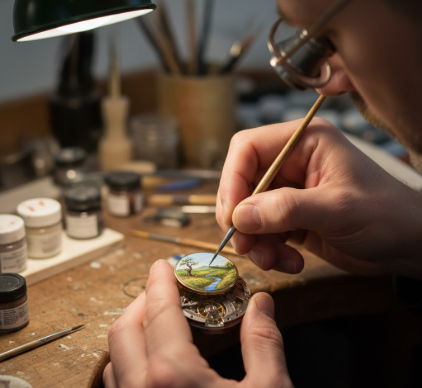In a world of mass production and digital immediacy, there exists a quiet, patient art form that marries the precision of horology with the soul of classical painting. It’s the craft of miniature enameling, the painstaking process of hand-painting intricate scenes onto the tiny canvas of a watch dial. This is not merely decoration; it’s storytelling on a microscopic scale, a tradition where artisans create entire worlds that can be worn on the wrist. A single dial can take hundreds of hours of focused labor, transforming a time-telling instrument into a unique masterpiece of wearable art.
A Canvas No Bigger Than a Coin
The first and most profound challenge is the scale. The average watch dial offers a surface area of only a few square centimeters. Upon this tiny disc, the artist must render landscapes, portraits, or replications of famous paintings with breathtaking detail. Every brushstroke is magnified, every color choice critical. The materials themselves present their own hurdles. The base is often a disc of gold or copper, which is then prepared for the true medium: enamel. This isn’t paint as we typically know it, but finely ground glass powder mixed with water or oil to form a paste.
Alternatively, some artisans work on whisper-thin slivers of mother-of-pearl. This material offers an ethereal, iridescent backdrop that can be used to simulate skies, water, or light in a way that enamel cannot. However, it is incredibly fragile and its organic surface requires a completely different approach to paint application, demanding a delicate touch to avoid cracking or dulling its natural luster.
The tools used by a miniature painter are as specialized as the craft itself. The work is performed under a high-power binocular microscope, allowing the artist to see the minute details they are creating. Their brushes are the finest available, often consisting of just a single, perfect hair from a marten’s tail, chosen for its unique ability to hold a point and deliver a microscopic droplet of color with absolute precision. The paints are custom-mixed from metallic oxides to create a specific palette that can withstand the intense heat of the kiln. Each color has its own chemical properties and reacts differently to firing, a science the artist must master alongside their painterly skills.
The Grand Feu technique, which translates to “Great Fire,” involves multiple kiln firings at temperatures exceeding 800°C (1472°F). Each new layer of colored enamel requires its own separate firing, with darker colors typically applied first as they can withstand more heat. The cumulative risk of cracking or discoloration means that dials that have undergone more than ten firings are exceptionally rare and treasured.
The Alchemy of Grand Feu Enameling
Among the various techniques,
Grand Feu enameling is considered the pinnacle of the art form. The process is a high-stakes dance with fire. It begins with building a base layer of enamel on both sides of the metal dial to prevent warping under the intense heat. This is fired in a kiln until the glass powder melts and fuses to the metal, creating a smooth, durable surface. This step is repeated several times to achieve a flawless, luminous white or black canvas.
Then, the painting begins. The artist applies a single color or a small section of the design and the dial goes back into the kiln. This process is repeated for every single color. With each firing, there’s a risk of failure. The dial could crack from thermal shock, dust could get trapped in the molten glass, or the colors could react unexpectedly and become muted or spoiled. It’s a relentless cycle of painting, firing, cooling, and inspecting. An artist may spend over a hundred hours on a single piece only to have it fracture in the final firing, forcing them to start over from scratch.
Painting Between the Flames
This iterative process is what gives Grand Feu enamel its signature depth and vibrancy. The colors are not just sitting on the surface; they are fused into it, becoming part of the glassy structure. This provides a permanence that no other painting medium can match—an enameled dial will not fade or discolor over centuries. The artist must think in layers, understanding how a translucent blue fired over a base of white will look different from the same blue applied in a thicker coat. They build the image slowly, from the foundational background colors to the finest foreground details, each layer a permanent commitment sealed by fire.
More Than a Timepiece: A Story on the Wrist
What emerges from the kiln is not just a watch component, but a unique piece of art. The final dial has a lustrous, almost liquid depth that photographs struggle to capture. Whether it depicts a serene Swiss landscape, the portrait of a loved one, or a dynamic historical scene, the image is imbued with the patience and skill of its creator. These watches are the antithesis of disposable technology. They are heirlooms, personal treasures that carry the signature of the artist and the story of their creation.
The ownership of such a piece is an intimate experience. It’s a personal connection to an age-old craft, a silent testament to the enduring human desire to create beauty in the most unlikely of places. In a flick of the wrist, one can gaze upon a work of art that represents the pinnacle of human dexterity and artistic vision, a miniature world born of fire, glass, and countless hours of unwavering dedication. It reminds us that sometimes the most profound beauty is found in the smallest of spaces.









